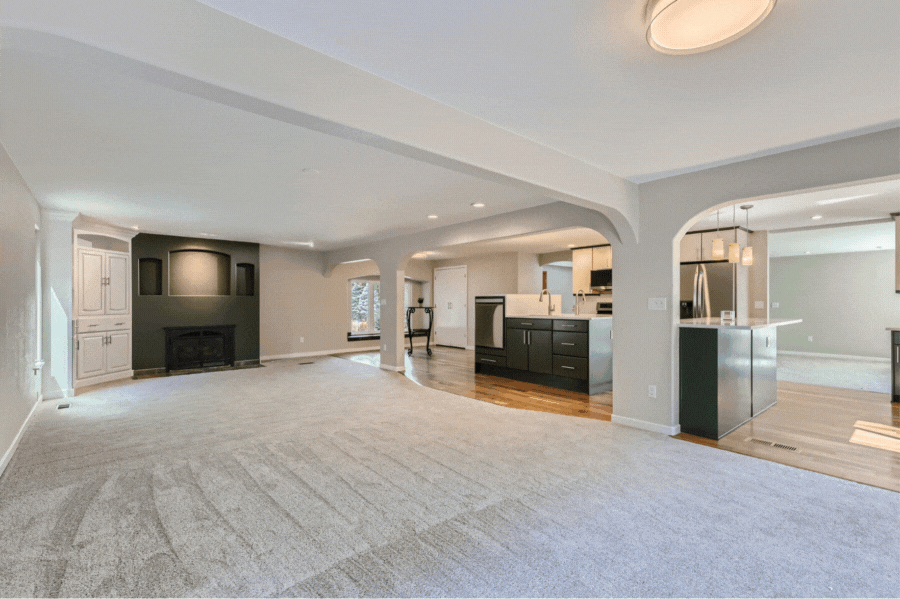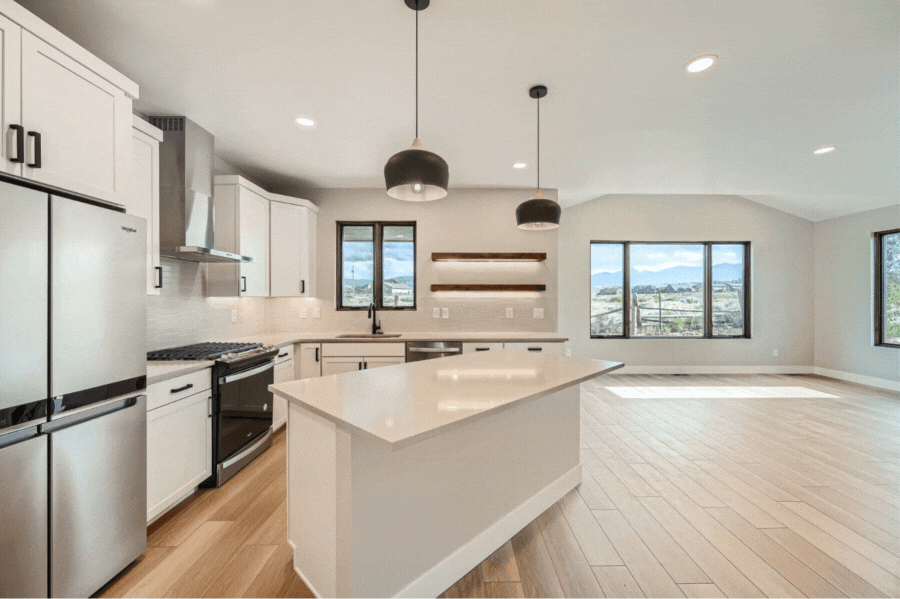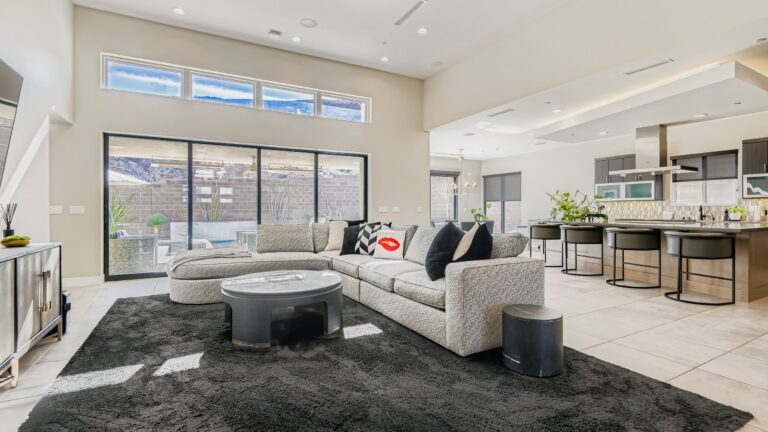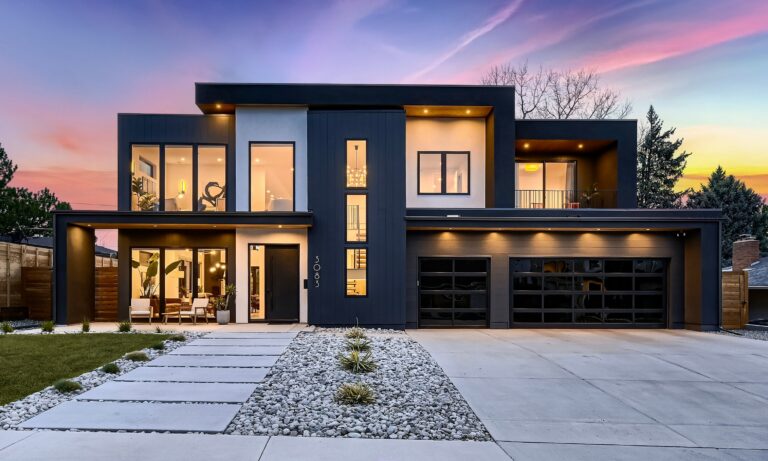Introduction to AI in Real Estate Virtual Staging
In recent years, AI has been transforming the real estate virtual staging process. By incorporating cost effective, scalable and integrated software solutions, alongside high resolution, AI-driven graphic editing software, virtual staging has allowed sellers and real estate agents to market their properties with ease.
These days it’s possible to analyse data on design trends and buyer behaviours, elevate creative input and stage properties with multiple rooms, all while keeping the virtual staging cost and turnaround time to a minimum.
In this post, we will delve into the impact of AI on virtual staging. We will look at how virtually staging properties can increase sales, learn about choosing a design style that makes homes sell and take a peek at what the future holds for real estate marketing.

The Evolution of Real Estate Virtual Staging
It is thought that the concept of staged homes first originated on America’s west coast in the 1970s. The term “stage” was coined by Barb Schwarz and “staging” was a way for real estate agents to prepare a home for sale. The process was lengthy – often involving changing the decor and room layout, adding new furniture and de-personalizing each space to appeal to broader audiences.
Virtually staged images first began to appear in the early 2000s. The earliest digital images involved virtual furniture pieces being added to photographs of empty rooms. It was a simple and somewhat rudimentary process yet found to be a cost effective way to present a home without physically staging or hiring an interior designer. The methods used helped to pave the way for the AI enhanced solutions that we see today.
Early Adoption of Virtual Staging Technologies
Before AI was fully integrated into the virtual staging arena, computer generated imagery or CGI and 3D modelling software was used. These software programs had the ability to digitally decorate and furnish empty listings, but they had limitations.
Firstly, there was a lack of professional expertise in using the software, which led to the static images often looking unrealistic to potential buyers. This made customers sceptical, and many believed that the properties weren’t being accurately portrayed. Additionally, the turnaround times were quite long and much of the software was incompatible with the real estate websites of the time. This led to the process being rather costly and time consuming for real estate agents.
How AI is Revolutionising Virtual Staging
As more advanced Artificial Intelligence tools have emerged, virtual staging services have transformed to become more data-driven. Today, machine learning algorithms trained on datasets and images can help to identify compatible, realistic designs and calculate accurate scaling for each room.
The software can embed specific colour schemes and even arrange furniture in a way that appeals to property seekers. Additionally, AR (Augmented Reality) can now be used to allow buyers to see how a virtually staged space would look through a smart device during an interactive simulated experience.
Image Enhancements with AI
The quality of virtually staged photos is also greatly enhanced by AI. By using advanced machine learning techniques, the software can produce lifelike image enhancements. Some key features include:
- Natural Lighting Effects: AI can simulate natural lighting and uses existing light sources to ensure that the virtually staged image remains as close to real life as possible.
- Calculating Shadows: Shadows can be calculated based on the furniture positioning and any existing light sources to make them appear believable and more natural.
- Adjusting Colours: AI can auto-adjust colours to ensure realism and software tools can fix any imbalances or saturation that may appear online.
- High-Res Textures: The textures that AI creates can make materials in the home look super realistic. From grains of wood to intricate woven fabrics and patterns, the characteristics of each textile and surface are enhanced to appear more realistic to potential buyers.
- Environmental Touch-ups: Virtually staged furniture can be integrated seamlessly into an existing photo environment and the space can be adapted to different times of the year to align with the time of promotion.
Cost Efficiency and Turnaround Time
There are many reasons why AI virtual staging would be more appealing than physically staging a home and one such reason is cost.
Costs for AI virtual staging offers can start from $15-$50 per photograph. It’s also easy to change specific furnishings or colours during the staging process or even after the initial 3D renders have been delivered.
Traditional staging in comparison can cost anywhere from $500 to $5000 USD depending on the size of the property and the work required. This is because physical home staging often involves renting furniture, employing decorators or interior designers and organising transportation.
Staging a property in person may take weeks or months, however virtually staged AI photos can be delivered in 24-48 hours, which means that the property can be released to market quicker and the quantity of real estate listings for agents can increase.
Real-World Applications of AI in Virtual Staging
A recent study by the National Association of Realtors stated that 81% of real estate agents said that virtual home staging made it easier for a buyer to visualise a property as their future home.
The Parker in Boston – a new luxury development has been known to virtually stage a number of its residences to illustrate how they can be designed or furnished to prospective owners.
AI-generated images and 360 virtual tours were also included as part of the successful website marketing campaign for the luxury Sandbank Villas project in Zanzibar.
Marketing properties in such a way often creates an emotional attachment with potential buyers and properties tend to sell faster. Twenty percent of estate agents said that virtual staging increased the property value between one and five percent compared to similar homes that were not staged.
Platforms such as Virtuance use AI-driven virtual staging offers to create elevated, realistic home imagery. Real estate professionals can upload photographs of empty properties and Virtuance’s proprietary software generates custom furnishings, fittings and decor. It’s a cost saving, and convenient exercise that far outweighs traditional staging.
Customizing Design Styles for Different Buyers
One of the great aspects of virtual staging is that it allows interiors to be customised to suit the styles of a target audience.
The software programs, using highly sophisticated algorithms, have the ability to suggest designs from modern and minimalistic to rustic and avant-garde that will resonate with a specific demographic, whether they are young professionals, families or retired couples.
Having the ability to change designs and room themes gives agents and sellers greater flexibility and it helps their properties appeal to broader audiences.
The Long-Term Impact of AI on Real Estate Virtual Staging
As AI machine learning evolves, virtual staging will too, and in the future, buyers will be able to see vast improvements in immersiveness, thanks to AR/VR virtual tours, realistic, customizable interiors and more data-driven insights.
These changes will enable agents to focus on building client trust and enhance their number of listings, leading to greater lead generation and sales. Early adopters integrating the technologies into their business practices are sure to benefit as the real estate landscape continues to change.
AI in Virtual Tours and Beyond
Creating AI virtual tour environments using AR/VR and even the metaverse can attract potential buyers viewing properties online from overseas locations. It helps to give them a sense of place while also allowing developers to promote off-plan projects with the idea of a finished product. Using AI virtual tours also helps to:
- Personalise the Property
- Enhance Realism
- Appeal to Diverse Audiences
- Generate Engaging Content
- Establish a Sense of Place for Buyers
Embracing the AI Revolution in Real Estate
The use of ultra realistic imagery, creativity, marketing analytics and data-driven insights, coupled with a quick turnaround and competitive cost of staging photos, can now help real estate agents enhance promotional campaigns and engage their target audiences every time they list a new property.
Although there will always be a requirement for traditional staging, it will be interesting to see where the next-generation of AI virtual staging software takes us.
If you want to enhance your listings with virtual staging, explore Virtuance’s virtual staging services. For those seeking tailored real estate marketing advice, Proven Partners offers expert solutions in development advisory, brand development, marketing activations, and driving optimal sales results. Visit their website to learn how they can support your next project.

Author Bio

Colin Hannan is the Principal of Proven Partners, a real estate marketing agency that bridges commercial and creative expertise to bring luxury real estate projects to life. Colin helps businesses in the real estate industry to create impactful brands and meaningful concepts to drive sales, partnering with progressive hospitality brands and independent developers to build projects that truly stand out.








